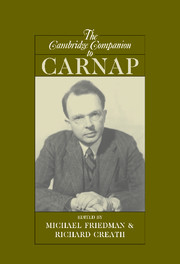Book contents
- Frontmatter
- Introduction: Carnap’s revolution in philosophy
- 1 Carnap’s intellectual development
- 2 Geometrical leitmotifs in Carnap’s early philosophy
- 3 Carnap and Frege
- 4 Carnap and Husserl
- 5 Carnap, Russell, and the external world
- 6 The Aufbau and the rejection of metaphysics
- 7 Carnap and the Vienna Circle: rational reconstructionism refined
- 8 Carnap and modern logic
- 9 Tolerance and logicism: logical syntax and the philosophy of mathematics
- 10 Carnap’s quest for analyticity: the Studies in Semantics
- 11 Carnap on the rational reconstruction of scientific theories
- 12 Carnap on probability and induction
- 13 Carnapian pragmatism
- 14 Quine’s challenge to Carnap
- Bibliography
- Index
1 - Carnap’s intellectual development
Published online by Cambridge University Press: 28 April 2008
- Frontmatter
- Introduction: Carnap’s revolution in philosophy
- 1 Carnap’s intellectual development
- 2 Geometrical leitmotifs in Carnap’s early philosophy
- 3 Carnap and Frege
- 4 Carnap and Husserl
- 5 Carnap, Russell, and the external world
- 6 The Aufbau and the rejection of metaphysics
- 7 Carnap and the Vienna Circle: rational reconstructionism refined
- 8 Carnap and modern logic
- 9 Tolerance and logicism: logical syntax and the philosophy of mathematics
- 10 Carnap’s quest for analyticity: the Studies in Semantics
- 11 Carnap on the rational reconstruction of scientific theories
- 12 Carnap on probability and induction
- 13 Carnapian pragmatism
- 14 Quine’s challenge to Carnap
- Bibliography
- Index
Summary
ORIGINS
The young Carnap is not easy to classify. He was neither really a scientist nor a proper philosopher. Among scientists he felt temperamentally at home, but he regretted the slovenliness of the enterprise. The officers at headquarters, he thought, needed to bring some order to operations on the front. Unfortunately these “officers” – the neo-Kantian philosophers whose lectures he attended in Jena and Freiburg before the First World War – seemed too unsure of the terrain to guide the scientific sappers in their spadework of intellectual trench warfare.
But Carnap did not reject the neo-Kantian tradition he grew up in. He assimilated a good deal of it. The impulse for the revival of Kant in mid-nineteenth-century Germany had originally come from the natural sciences rather than philosophy, particularly from the great physicist and physiologist Hermann von Helmholtz. He and the philosophers who followed his lead had wanted to complete the job of eliminating metaphysics that Kant, in their view, had left unfinished. Helmholtz’s physiology of perception, they thought, could render the transcendental aesthetic metaphysically harmless. Though they held that the subjective feelings of spatiality and temporality are built into our perceptual system, just as Kant had argued, this did not mean that the geometry governing the perceived world was put there by human perception. We have no idea, Helmholtz said, whether physical space is Euclidean or non-Euclidean; this is an empirical question like any other, to be settled by going out and looking. So much, Helmholtz had thought, for Kant’s best example of supposedly synthetic a priori knowledge.
- Type
- Chapter
- Information
- The Cambridge Companion to Carnap , pp. 19 - 42Publisher: Cambridge University PressPrint publication year: 2007
- 12
- Cited by



